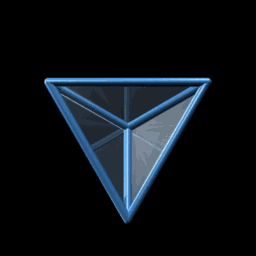Sage Interactions - Loop Quantum Gravity
goto interact main page
Contents

Holomorphic factorization of the Quantum Tetrahedron
by David Horgan.
Moduli Space of Shapes of a Tetrahedron with Faces of Equal Area
The space of shapes of a tetrahedron with fixed face areas is naturally a symplectic manifold of real dimension two. This symplectic manifold turns out to be a Kähler manifold and can be
parametrized by a single complex coordinate Z given by the cross ratio of four complex numbers obtained by stereographically projecting the unit face normals onto the complex plane.
This Demonstration illustrates how this works in the simplest case of a tetrahedron T whose four face areas are equal. For convenience, the cross-ratio coordinate Z is shifted and rescaled
to z=(2Z-1)/Sqrt[3] so that the regular tetrahedron corresponds to z=i, in which case the upper half-plane is mapped conformally into the unit disc w=(i-z)/(i+z). The equi-area tetrahedron
T is then drawn as a function of the unit disc coordinate w.
Reference: L. Freidel, K. Krasnov, and E. R. Livine, "Holomorphic Factorization for a Quantum Tetrahedron".
xxxxxxxxxx# -*- coding: utf-8 -*-"""Created on Mon Feb 10 20:05:11 2014@author: David Horgan"""from scipy.optimize import fsolveimport math#scene.range = 10#cylinder(pos=(0,0,0), radius=1.0,axis=(0,0,1), color=color.white)#scene2 = display(title='Examples of Tetrahedrons', # x=0, y=0, width=600, height=600, # center=(0,0,0), background=(1,1,1))#scene2.visible = True#scene2.range = 10#unit circle plotC = circle((0,0), 1)#input points from unit circlep1=0.6p2=0.7#face1a1=(((1 - p2**2)/(2*(1 + p1)))**(1/4), (1/2)*(p2 + 1)*((2*(1 + p1))/(1 - p2**2))**(1/4), 0)a2=(((1 - p2**2)/(2*(1 + p1)))**(1/4), (1/2)*(p2 - 1)*((2*(1 + p1))/(1 - p2**2))**(1/4), 0 )a3=(((1/2)*( (1 + p1)**3)* (1 - p2**2))**(1/4),p2*((2*(1 + p1))/(1 - p2**2))**(1/4), sqrt(1 - p1**2)*((1 - p2**2)/(2*(1 + p1)))**(1/4) )a=[a1,a2,a3]#face2b1=(0, 0, 0)b2=(((1 - p2**2)/(2*(1 + p1)))**(1/4), (1/2)*(p2 - 1)*((2*(1 + p1))/(1 - p2**2))**(1/4), 0)b3=(((1/2)*((1 + p1)**3)*(1 - p2**2))**(1/4),p2*((2*(1 + p1))/(1 - p2**2))**(1/4), sqrt(1-p1**2)*((1-p2**2)/(2*(1+p1)))**(1/4) )b=[b1,b2,b3]#face3c1=(0, 0, 0)c2=( ((1 - p2**2)/(2*(1 + p1)))**(1/4), (1/2)*(p2 + 1)*((2*(1 + p1))/(1 - p2**2))**(1/4), 0)c3=(((1/2)*((1 + p1)**3)*(1 - p2**2))**(1/4), p2*((2*(1 + p1))/(1 - p2**2))**(1/4), sqrt(1 - p1**2)*((1 - p2**2)/(2*(1 + p1)))**(1/4) )c=[c1,c2,c3]#face4d1=(0, 0, 0)d2=(((1 - p2**2)/(2*(1 + p1)))**(1/4), (1/2)*(p2 + 1)*((2*(1 + p1))/(1 - p2**2))**(1/4), 0)d3 =(((1 - p2**2)/(2*(1 + p1)))**(1/4), (1/2)*(p2 - 1)*((2*(1 + p1))/(1 - p2**2))**(1/4), 0)d=[d1,d2,d3]#printresultsprint('a1={}'.format(a1))print('a2={}'.format(a2))print('a3={}'.format(a3))print('b1={}'.format(b1))print('b2={}'.format(b2))print('b3={}'.format(b3))print('c1={}'.format(c1))print('c2={}'.format(c2))print('c3={}'.format(c3))print('d1={}'.format(d1))print('d2={}'.format(d2))print('d3={}'.format(d3))G = Graphics()#tetrahedron faces - colouredP1=polygon([a1,a2, a3], color='red')P2=polygon([b1,b2, b3],color='yellow')P3=polygon([c1,c2, c3],color='blue')P4=polygon([d1,d2, d3],color='green')#polygon faces#P1=polygon([a1,a2, a3])#P2=polygon([b1,b2, b3])#P3=polygon([c1,c2, c3])#P4=polygon([d1,d2, d3])#polygon([a1,a2, a3])#polygon([b1,b2, b3])#polygon([c1,c2, c3])#polygon([d1,d2, d3])g=G+P1+P2+P3+P4show(g, title='tet(w)', viewer='tachyon')show(C, title='w plane')
Quantum tetrahedron volume, area and angle eigenvalues
by David Horgan.
In this interact I calculate the angle, area and volume for a quantum tetrahedron The angle is found using the expression: theta = arccos((j3*(j3+1)-(j1*(j1+j1)-j2*(j2+1))/(2*sqrt(j1*(j1+j1)*j2*(j2+1)))) The area is found using the expression: A=sqrt(j1*(j1+1)) The volume is fund using the expression V^2 =M = 2/9(real antisymmetrix matrix)
Values of constants gamma is Immirzi parameter gamma =numerical_approx( ln(2)/(pi*sqrt(2))) #G = 6.63*10^-11 hbar= (1.61619926*10^-35)/(2*pi) lp is the planck length lp3=6*10^-104 Reference: Bohr-Sommerfeld Quantization of Space by Eugenio Bianchi and Hal M. Haggard. Reference: Shape in an atom of space: exploring quantum geometry phenomenology by Seth A. Major.
Research Blog: http://quantumtetrahedron.wordpress.com
Given the values of J1, J2, J3 and J4 this interact calculates the volume, area and angle eigenvalues of a quantum tetrahedron.
xxxxxxxxxximport numpydef _(j1 = input_box(6.0, 'J1'), j2= input_box(6.0, 'J2'), j3= input_box(6.0, 'J3'), j4= input_box(7.0, 'J1'), auto_update=False): if (j1+j2)<= (j3+j4): html('<h3>Value of Angle eigenvalue in radians</h3>') d2=j3*(j3+1) d3=j1*(j1+1) d4=j2*(j2+1) d5=d2-d3-d4 d6=2*sqrt(d3*d4) d7=d5/d6 d8=arccos(d7) d8a=numerical_approx(d8, digits=4) angle = numerical_approx(d8*180/pi, digits=4) if angle != NaN: print('angle between faces 1 and 2 in quantum tetrahedron = {} radians'.format(d8a)) print('angle between faces 1 and 2 in quantum tetrahedron = {} degrees'.format(angle)) html('<h3>main sequence Area eigenvalues</h3>') lp=1.61619926*10^-35 main1=numerical_approx(sqrt(j1*(j1+1)),digits=4) areamain1 =0.5*lp^2*main1 print('Area of face 1=', areamain1, 'm2') main2=numerical_approx(sqrt(j2*(j2+1)),digits=4) areamain2 =0.5*lp^2*main2 print('Area of face 2=', areamain2, 'm2') main3=numerical_approx(sqrt(j3*(j3+1)),digits=4) areamain3 =0.5*lp^2*main3 print('Area of face 3=', areamain3, 'm2') main4=numerical_approx(sqrt(j4*(j4+1)),digits=4) areamain4 =0.5*lp^2*main4 print('Area of face 4=', areamain4, 'm2') area = areamain1 + areamain3 +areamain3+areamain4 print('Total area of quantum tetrahedron =', area, 'm2') html('<h3>Values of Volume Eigenvalue</h3>') kmin = int(max(abs(j1-j2),abs(j3 -j4))) kmax = int(min((j1+j2),(j3 +j4))) d = kmax -kmin + 1 y=numpy.arange(kmin,kmax+1,1) kmatrix = matrix(CDF,int(d), int(d)) r=list() for j in range(d): k=int(y[j]) c1 = -i*k c2 = sqrt(4*k*k - 1) c3 = sqrt(j1*(j1+1)) c4 = sqrt((2*j1+1)) c5 = sqrt(j3*(j3+1)) c6 = sqrt((2*j3+1)) c7 = wigner_6j(j1,1,j1,k,j2,k-1) c8 = wigner_6j(j3,1,j3,k,j4,k-1) a = c1*c2*c3*c4*c5*c6*c7*c8 r.append(a) q = numerical_approx(a, digits=10) for j in range(d-1): kmatrix[[j],[j+1]]=r[j+1] kmatrix[[j+1],[j]]=-r[j+1] M = (2/9)*kmatrix s = M.eigenvalues() lp3=6*10^-104 for j in range(d): e = sqrt(s[j]) vol = lp3*e volume = numerical_approx(vol, digits=2) if e.imag() ==0: print("volume eigenvalue =", e) print("volume of tetrahedron =", volume, 'm3')
Quantum tetrahedron Area Operator eigenvalues
by David Horgan.
Given the values of J1, J2, J3 and J4 this interact calculates the area eigenvalues of a quantum tetrahedron.
xxxxxxxxxxhtml('<h3>Quantum tetrahedron Volume and Angle Eigenvalues</h3>')html('Enter the four J values into the input boxes')html('k values k ranges from kmin to kmax in integer steps')html('The dimension d of the Hilbert space H4, d = kmax - kmin + 1')html('kmin = max(|j1-j2|,|j3 -j4|) kmax = min(j1+j2,j3 +j4)')html('The the dimension of the hilbert space is given by d = kmax -kmin + 1') html('V^2 =M = 2/9(real antisymmetrix matrix))')html('Spins must satisfy (j1+j2)<= (j3+j4)')html('Reference: Bohr-Sommerfeld Quantization of Space by Eugenio Bianchi and Hal M. Haggard ')html('Reference: Shape in an atom of space: exploring quantum geometry phenomenology by Seth A. Major ')import numpydef _(j1 = input_box(6.0, 'J1'), j2= input_box(6.0, 'J2'), j3= input_box(6.0, 'J3'), j4= input_box(7.0, 'J1'), auto_update=False): if (j1+j2)<= (j3+j4): html('<h3>Value of Angle eigenvalue in radians</h3>') d2=j3*(j3+1) d3=j1*(j1+1) d4=j2*(j2+1) d5=d2-d3-d4 d6=2*sqrt(d3*d4) d7=d5/d6 d8=arccos(d7) print("Angle eigenvalue in radians=", d8) html('<h3>Values of Volume Eigenvalue</h3>') kmin = int(max(abs(j1-j2),abs(j3 -j4))) kmax = int(min((j1+j2),(j3 +j4))) d = kmax -kmin + 1 y=numpy.arange(kmin,kmax+1,1) kmatrix = matrix(CDF,int(d), int(d)) r=list() for j in range(d): k=int(y[j]) c1 = -i*k c2 = sqrt(4*k*k - 1) c3 = sqrt(j1*(j1+1)) c4 = sqrt((2*j1+1)) c5 = sqrt(j3*(j3+1)) c6 = sqrt((2*j3+1)) c7 = wigner_6j(j1,1,j1,k,j2,k-1) c8 = wigner_6j(j3,1,j3,k,j4,k-1) a = c1*c2*c3*c4*c5*c6*c7*c8 r.append(a) q=numerical_approx(a, digits=10) for j in range(d-1): kmatrix[[j],[j+1]]=r[j+1] kmatrix[[j+1],[j]]=-r[j+1] M = (2/9)*kmatrix s = M.eigenvalues() lp3=6*10^-104 for j in range(d): e= sqrt(s[j]) vol = lp3*e volume = numerical_approx(vol, digits=2) if e.imag() ==0: print("volume eigenvalue =", e) print("volume of tetrahedron in m3 =", volume)